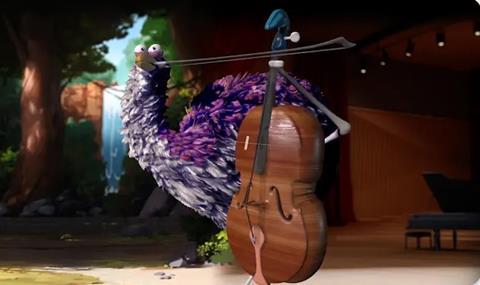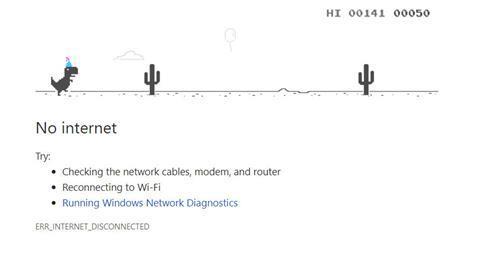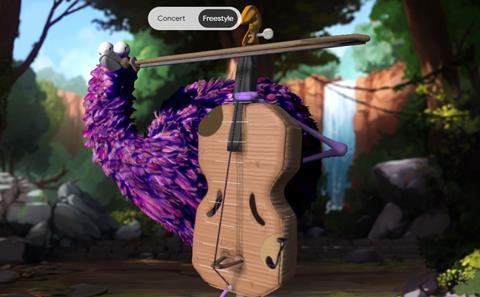Online editor and real-life cellist Davina Shum shares her and The Strad team’s thoughts on ’Viola the Bird’, Google’s newest music-meets-tech game

Discover more Featured Stories like this in The Strad Playing Hub
In a similar vein to musical games such as Guitar Hero and Trombone Champ comes ’Viola’ - Google’s new cello-playing AI bird.
Now, I love the challenge of a video game. Anyone who knows me is well aware that I can be found whiling away free time glued to my Nintendo Switch, challenging friends to a Mario Kart tournament, or lately, splayed on my couch on a Sunday playing Legend of Zelda: Tears of the Kingdom (once you start playing that game, it is very difficult to stop - if you know, you know). Sometimes when I lose internet connection, I’ll spend ages on Google Chrome playing that dinosaur jumping game.

So when I heard about Google and David Li’s latest music-meets-tech collaboration, ’Viola the Bird’, where you control a big purple bird playing a cello, obviously I had to drop everything to try it.
Viola the Bird is described by Google as the world’s first stringed instrument ’bird-tuoso’. Using your computer mouse, you drag the bow, which is held in Viola’s mouth, across the single string of a cello standing upright. There are two playing modes: concert and freestyle. In concert mode, you are directed to replicate a tune by coinciding your bow strokes with a vertical line that displays how long to play for. Luckily, pitch is taken care of; Viola the Bird’s left hand - or rather, leg?! - is holding up the neck of the cello (not that it appears to be doing much) so all you have to do is hold down the button and move your mouse from left to right. It’s more a rhythm game than anything else.
I was surprised by the number of pieces on offer in concert mode. I started off with Beethoven’s ‘Ode to Joy’, which was simple enough. Scrolling through, I couldn’t help but try my hand (leg…neck?) at Pachelbel’s Canon in D - having played that bass-line numerous times at weddings as a bored cellist, I was delighted to have a go playing the melody! But it got rather challenging in the section with demisemiquavers (I can hear the Americans crying ‘32nd notes!’) as my mouse action resembled furious tremolo skating across my desktop. You can also opt to play the Prelude from Bach’s Solo Cello Suite no.1 (luckily those three-note slurs across the strings are taken care of - you just need to pull the bow for the duration), as well as Schubert’s Ave Maria and ‘Jupiter’ from Holst’s The Planets.
As a string player, I had to get my head around the way that the AI directs you to drag your mouse to the right first (as if you’re doing a down bow) but this is reversed in Viola’s actions - she pushes the bow with her (hilariously) lanky neck when you go right so it looks like you’re doing an up bow instead.
’I finished on an up bow!’ I lamented, as I reached the end of ‘Ode to Joy’.

Read: Popper studies: celebrating the small victories
Read: Vibrato: three reminders from our online editor Davina Shum
Chaos ensued in freestyle mode. Viola the Bird is transported from the concert hall and placed in front of a backdrop of a waterfall and stone ruins (where is she?!) where her cello is replaced with a cruder, prehistoric version of the instrument. It appears to be made of corrugated cardboard. The bridge seems to have dropped down to where the tailpiece should be. In freestyle mode, this time you can control the pitch - not with your left leg as you may expect, but by changing the contact point location on the string. This means that in order to play a high pitch, you bow super sul tasto, while to play a low note, you bow sul ponticello.
*cringe*
OK, I shouldn’t take it too seriously. But it is pretty funny, and addictive too. And perhaps a good opportunity to discover great works of repertoire for those who are unfamiliar.
I put it towards other members of The Strad editorial team, who put their skills to the test.
’It’s strangely fun, but having to change direction on every note is annoying,’ said Emma, The Strad’s editor. Ever musical, she continued, ’I want to PHRASE it.’
’It’s quite fun - not really a musical instrument though,’ said Christian, our managing editor, who also felt limited by the technology. ’I couldn’t see how to play sharps or flats, so it just seems to offer whole tones; also playing slowly seemed to be near impossible - the slower I got, the quieter it got as well!’
According to Google, the technology was developed with cellists and violinists Ashok Klouda, Dave Larkin, Elizabeth Goble, Peter Wilson, Zhivko Georgiev, and music arrangers Charles Mauleverer and Martin Batchelar. They developed the experiment by training a neural network — a machine learning model that can be trained on data — to understand cello and violin compositions. The neural network was then applied to create a real-time audio synthesis engine that can generate the sounds of a cello or violin based on the player’s input.
’Viola the Bird is a great way for anyone to learn about stringed instruments and to explore their own creativity through music,’ says Google.
‘I have made contemporary music!’ proclaimed Emma.
While we agree it’s a bit of fun, it’s certainly no substitute for picking up a real instrument in your hands (not your leg). As Christian said, ’it’s a bit like claiming you could pass your driving test after a few games of Grand Theft Auto.’
Want to have a go? Try your neck at Viola the Bird here: https://artsandculture.google.com/experiment/nAEJVwNkp-FnrQ
Read: Violin making and AI: Intelligent design
Read: Analysis July 2023: Artificial intelligence in music education
Read more Featured Stories like this in The Strad Playing Hub
The number one source for playing and teaching books, guides, CDs, calendars and back issues of the magazine.
In The Best of Technique you’ll discover the top playing tips of the world’s leading string players and teachers. It’s packed full of exercises for students, plus examples from the standard repertoire to show you how to integrate the technique into your playing.
The Strad’s Masterclass series brings together the finest string players with some of the greatest string works ever written. Always one of our most popular sections, Masterclass has been an invaluable aid to aspiring soloists, chamber musicians and string teachers since the 1990s.
This year’s calendar celebrates the top instruments played by members of the Australian Chamber Orchestra, Melbourne Symphony, Australian String Quartet and some of the country’s greatest soloists.













































No comments yet